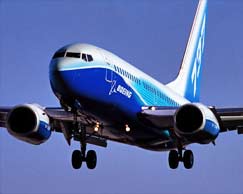Continental flies Boeing 737-800 on biofuel for 90 minutes
09 Jan 2009
 Continental Airlines yesterday conducted a test flight for 90 minutes, flying a Boeing 737-800 on a blend of avaition fuel and biofuel derived from algae and jatropha plants, demonstrating the use of biofuel to power a commercial aircraft for the first time ever in North America.
Continental Airlines yesterday conducted a test flight for 90 minutes, flying a Boeing 737-800 on a blend of avaition fuel and biofuel derived from algae and jatropha plants, demonstrating the use of biofuel to power a commercial aircraft for the first time ever in North America.
 The demonstration flight by Continental Airlines was the latest test conducted on the new generation sustainable biofuels that could eventually help airlines cut its massive fuel costs and also reduce carbon emissions.
The demonstration flight by Continental Airlines was the latest test conducted on the new generation sustainable biofuels that could eventually help airlines cut its massive fuel costs and also reduce carbon emissions.
Last week, Air New Zealand became the world's first airline to successfully fly a Boeing 747 partially fuelled by jatropha oil using a 50-50 blend of standard jet fuel and biofuel made from the oil of jatropha plant seeds to power one of the engines on a Boeing 747 during a two-hour test flight.
However, Virgin Atlantic was the first to fly a commercial aircraft in February 2008 between London's Heathrow and Amsterdam using fuel derived from a mixture of Brazilian babassu nuts and coconuts in the 747's tank. It was a mere 5 per cent of the total fuel mix, with three of the plane's four tanks filled with standard jet fuel, while one contained the 20-per cent coconut oil and babassu nuts.
The Continental Airlines test flight, which took off from Houston's Bush Intercontinental Airport, completed a round over the Gulf of Mexico and pilots carried out a series of tests at 38,000 feet.
Test pilots engaged the aircraft in a number of normal and "non-normal" flight maneuvers, such as mid-flight engine shutdown and re-start, and power accelerations and decelerations. A Continental engineer recorded flight data onboard.
The aircraft's number one engine operated on 100 per cent traditional jet fuel, allowing Continental to compare performance between the biofuel blend and traditional fuel.
Continental officials told reporters on the ground that the engine fed on the biofuels-mix burned only 3,600 pounds of fuel, compared with 3,700 pounds of fuel for the engine flying on conventional fuel.
The biofuels-mix saved 100 pounds of fuel, or 0.03 per cent of the regular load.
Continental's demonstration flight was conducted in partnership with Boeing, GE Aviation / CFM International, and Honeywell's UOP, and marks the first sustainable biofuel demonstration flight by a commercial carrier using a two-engine aircraft, a Boeing 737-800 equipped with CFM International CFM56-7B engines.
Continental, Boeing, GE Aviation / CFM and UOP woked jointly for over nine months to carefully evaluate and test the biofuel in engines on the ground.
"We still have a lot of work to do in terms testing various biofuels but we are very pleased with, and encouraged by, the results we have achieved to date," said Eric Bachelet, president and CEO of CFM International. "What we have found is that the second generation fuel being tested today comes closer to simulating the characteristics of traditional jet fuel in terms of engine performance and operability, such as fuel."
"We are excited to be pioneering the development of bio-based jet fuels along with Continental Airlines," said Sanjay Pingle, president, Terasol Energy. "Jatropha is one of several next generation fuel sources that we are working on in order to develop sustainable, scalable and renewable alternatives to petroleum-based products."
"This demonstration flight represents another step in Continental's ongoing commitment to fuel efficiency and environmental responsibility," said chairman and chief executive officer, Larry Kellner. "The technical knowledge we gain today will contribute to a wider understanding of the future for transportation fuels."
The biofuel blend included components derived from algae and jatropha plants, both sustainable, second-generation sources that do not impact food crops or water resources or contribute to deforestation.
The algae oil was provided by Sapphire Energy, and the jatropha oil by Terasol Energy. This is the first time a commercial carrier powered a flight using fuel derived in part from algae.
The biofuel is a "drop-in" fuel, and no modifications to the aircraft or engine were made for the flight to operate.
In August last year, the US Air Force flew an F-15 Eagle at more than twice the speed of sound using a blend of synthetic fuel. The test flight was the world's first test of a high performance
The fighter aircraft was powered by a 50-50 mix of traditional JP-8 jet fuel and a synthetic using natural gas as a source.
Though the US Air Force had already tested the new blend on a C-17 cargo aircraft and B-52 and B-1 bombers, experts concluded that fighter aircraft offered a much different challenge.
This month Japan Airlines will become the first Asian carrier to test a flight using fuel refined from the energy crop, camelina and a mixture of two second-generation biofuel feedstocks, jatropha and algae, using a blend of 50 per cent biofuel and 50 per cent traditional Jet-A jet fuel on a B747-300 aircraft.
In 2003 NASA successfully tested an alternative paraffin-based fuel rocket fuel, developed after two years of collaboration between Stanford University, Palo Alto, California, and NASA's Ames Research Centre.







.webp)














